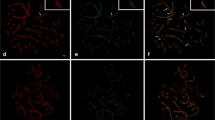Abstract
Biotinylated rat satellite DNA I probe p93-50 was used to visualize the chromatin of surface-spread rat pachytene chromosomes. Fluorescein isothiocyanate (FITC)-conjugated avidin produces a beaded fluorescence pattern along the chromatin loops that insert in the centromeric region of the synaptonemal complex (SC), the paired cores of homologous chromosomes. The number of fluorescent beads ranges from zero for centromeres without satellite DNA I homologous to probe p 93-50, to several hundred for satellite-rich centromeric regions. For the chromosomes that can be identified, the relative amount of satellite DNA is chromosome specific. No satellite DNA I was detected at the non-centromeric ends of the chromosomes or interstitially. DNase-digested nuclei or isolated SCs did not have detectable amounts of satellite DNA in the centromeric regions of the chromosomes or in the residual SCs. The fate of the satellite DNA was followed during spermiogenesis. In the round spermatid the centromeric regions, which appear to be attached to the nuclear envelope, are still distinct and have converging loops of fluorescent chromatin. At later stages there are fewer but still bright fluorescent patches. Satellite DNA I is still detectable in the mature sperm head. These results demonstrate the organization of satellite DNA I in the chromatin loops at the centromeric regions, and they forecast the analysis of chromosome organization in unprecedented detail with a variety of probes in surface spreads of meiotic prophase chromosomes.
Similar content being viewed by others
References
Brinkley BR, Brenner SL, Hall JM, Tousson A, Balczon RD, Valdivia MM (1986) Arrangements of kinetochores in mouse cells during meiosis and spermiogenesis. Chromosoma 94:309–3417
Counce SJ, Meyer GF (1973) Differentiation of the synaptonemal complex and the kinetochore in Locusta spermatocytes studied by whole mount electron microscopy. Chromosoma 44:231–253
Cremisi F, Vignali R, Batistoni R, Barsacchi G (1988) Heterochromatic DNA in Triturus (Amphibia, Urodela) II. A centromeric satellite DNA. Chromosoma 97:204–211
Dresser ME (1987) The synaptonemal complex and meiosis: an immunocytochemical approach. In: Moens PB (ed) Meiosis. Academic Press, New York, pp 245–274
Dresser ME, Moses MJ (1980) Synaptonemal complex karyotyping of the Chinese hamster (Cricetulus griseus). IX. Light and electron microscopy of synapsis and nucleolar development by silver staining. Chromosoma 76:1–22
Feinberg AP, Vogelstein B (1983) A technique for radiolabeling DNA restriction endonuclease fragments to high specific activity. Anal Biochem 132:6–13
Heyting C, Dettmers RJ, Dietrich AJJ, Redeker EJW, Vink ACG (1988) Two major components of the synaptonemal complex are specific for meiotic prophase nuclei. Chromosoma 96:325–332
Heyting C, Dietrich AJJ, Moens PB, Dettmers RJ, Offenberg HH, Redeker EJW, Vink ACG (1989) Synaptonemal complex proteins. Genome 31:81–87
Hutchison NJ, Langer-Safer PR, Ward DC, Hamkalo BA (1982) In situ hybridization at the electron microscope level: hybrid detection by autoradiography and colloidal gold. J Cell Biol 95:609–618
Lawrence JB, Villnave CA, Singer RH (1988) Sensitive, high-resolution chromatin and chromosome mapping in situ: Presence and orientation of two closely integrated copies of EBV in a lymphoma line. Cell 52:51–61
Li S, Meistrich ML, Brock WA, Hsu TC, Kuo MT (1983) Isolation and preliminary characterization of the synaptonemal complex from rat pachytene spermatocytes. Exp Cell Res 144:63–72
Maniatis T, Fritsch EF, Sambrook J (1982) Molecular cloning: a laboratory manual. Cold Spring Harbor Laboratory, NY
Manuelidis L, Langer-Safer PR, Ward DC (1982) High-resolution mapping of satellite DNA using biotin-labeled DNA probes. J Cell Biol 95:619–625
Mitchell AR, Ambros P, McBeath S, Chandley AC (1986) Molecular hybridization to meiotic chromosomes in man reveals sequence arrangement on the No. 9 chromosome and provides clues to the nature of “parameres”. Cytogenet Cell Genet 41:89–95
Moens PB (1978) Lateral element cross connections of the synaptonemal complex and their relationship to chiasmata in rat spermatocytes. Can J Genet Cytol 20:567–579
Moens PB, Earnshaw WC (1989) Anti-topoisomerase II recognizes meiotic chromosome cores. Chromosoma, in press
Moens PB, Pearlman RE (1988) Chromatin organization at meiosis. BioEssays 9:151–153
Moens PB, Heyting C, Dietrich AJJ, van Raamsdonk W, Chen Q (1987) Synaptonemal complex antigen location and conservation. J Cell Biol 105:93–103
Pech M, Igo-Kemenes T, Zachau HG (1979) Nucleotide sequence of a highly repetitive component of rat DNA. Nucleic Acids Res 7:417–432
Radic MZ, Lundgren K, Hamkalo BA (1987) Curvature of mouse satellite DNA and condensation of heterochromatin. Cell 50:1101–1108
Sealy L, Hartley J, Donelson J, Chalkley R, Hutchison N, Hamkalo BA (1981) Characterization of a highly repetitive sequence DNA family in rat. J Mol Biol 145:291–318
Shen D, Wang Z, Wu M (1987) Gene mapping on maize pachytene chromosomes by in situ hybridization. Chromosoma 95:311–314
von Wettstein D, Rasmussen SW, Holm PB (1984) The synaptonemal complex in genetic segregation. Annu Rev Genet 18:331–431
Waye JS, Willard HF (1989) Chromosome specificity of satellite DNAs: short- and long-range organization of a diverged dimeric subset of human alpha satellite from chromosome 3. Chromosoma 97:475–480
Weith A, Traut W (1980) Synaptonemal complexes with associated chromatin in a moth, Ephestia kuehniella Z. Chromosoma 78:275–291
Witney FR, Furano AV (1983) The independent evolution of two closely related satellite DNA elements in rats (Rattus). Nucleic Acids Res 11:291–304
Author information
Authors and Affiliations
Rights and permissions
About this article
Cite this article
Moens, P.B., Pearlman, R.E. Satellite DNA I in chromatin loops of rat pachytene chromosomes and in spermatids. Chromosoma 98, 287–294 (1989). https://doi.org/10.1007/BF00327315
Received:
Revised:
Issue Date:
DOI: https://doi.org/10.1007/BF00327315




